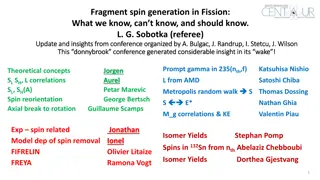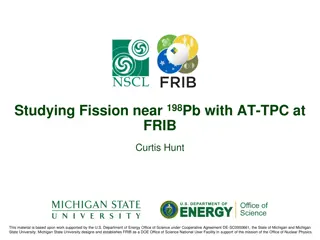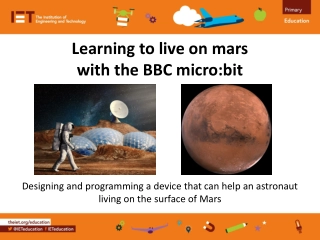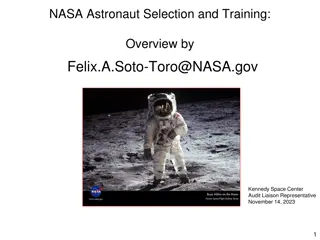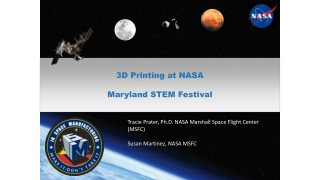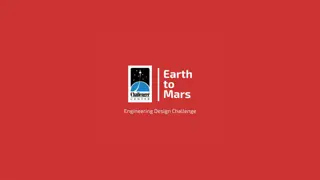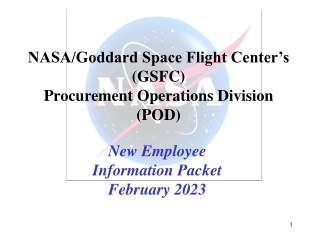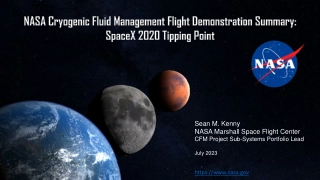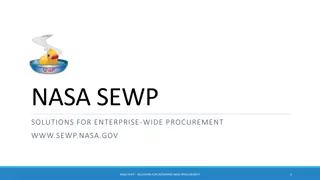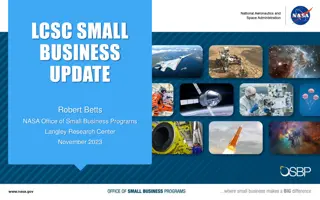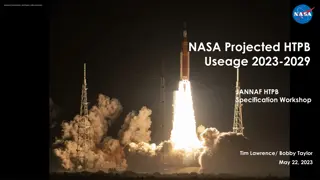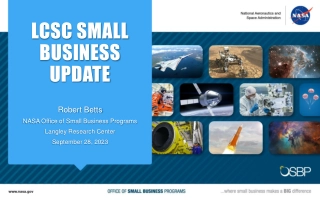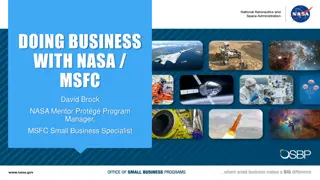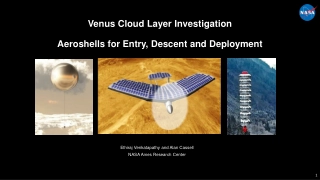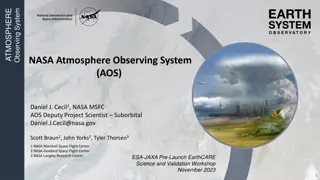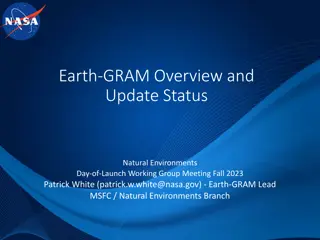NASA Fission Surface Power Overview: Enabling Sustainable Exploration of Moon and Mars
NASA's Fission Surface Power systems are pivotal for enabling sustainable energy production on the Moon and Mars, essential for human and scientific exploration missions. These nuclear power systems offer robust and continuous power in challenging environmental conditions, making them vital for supporting Artemis missions on the Moon and future Mars exploration endeavors.
Download Presentation
Please find below an Image/Link to download the presentation.
The content on the website is provided AS IS for your information and personal use only. It may not be sold, licensed, or shared on other websites without obtaining consent from the author. Download presentation by click this link. If you encounter any issues during the download, it is possible that the publisher has removed the file from their server.
Presentation Transcript
Overview of NASA Fission Surface Power The Space & Emerging Technologies (SET) Working Group (WG) of the U.S. Nuclear Industry Council (USNIC) March 27, 2023 Tim Smith NASA Glenn Research Center Sebastian Corbisiero Idaho National Laboratory
Why Develop a Fission Surface Power System? Nuclear Power for the Moon and Mars Nuclear power systems will enable robust exploration of the Moon and Mars Reliable and robust energy production is essential to human and scientific exploration missions to the Moon (to support Artemis) and Mars Fission power systems can provide abundant and continuous surface power in all environmental conditions on the Moon and Mars: Lunar night is 14.5 Earth days long and permanently shadowed regions may contain water ice. Surface nuclear power is required for a sustainable lunar presence Mars has recurring planet-wide dust storms that can last for weeks or months A fission system designed for a capability demonstration on the Moon will be directly applicable to human Mars exploration Recent analyses indicate that a Mars fission surface power system is likely to enable 2x less mass to be flown to space and be more reliable than a comparable solar power system in the 10 to 40 kWe class 2
Brief History of NASA Developments 2020 2015 2010 2005 2000 Prometheus Fission Surface Power Kilopower FSP 2.0 40 kWe, 8 yr life Long-duration lunar & Mars surface power 900K NaK-cooled UO2 reactor with Stirling 5800 kg, 145 kg/kWe Non-nuclear system test completed (~$50M spent) 200 kWe, 20 yr life NEP science mission to Jovian moons 1200K HeXe-cooled UN reactor with Brayton 6600 kg, 33 kg/kWe Prime selected and PMSR completed (~$400M spent) 1 kWe, 10 yr life Low-tech fission alternative to RPS 1100K Na HP-cooled UMo reactor with Stirling 400 kg, 400 kg/kWe Reactor prototype test completed (~$20M spent) 3
What is a Fission Surface Power System? The Fission Surface Power hardware development is part of NASA Space Technology Mission Directorate s (STMD) Space Nuclear Technologies Portfolio Fission Surface Power Nuclear Thermal Propulsion and Nuclear Electric Propulsion It is an autonomous nuclear power system that is launched, placed on the Moon s surface by a lander, transported to its operational location, activated, and connected to a user power interface up to a kilometer away NASA and the Department of Energy (DOE) are collaborating on the development of a 40 kWe lunar fission power system for delivery to the launch site by 2028 It will have a ten-year life, consisting of a 1-year demonstration followed by operational support for Artemis It will be designed so it is extensible to Mars missions 4
Fission Surface Power System Development Strategy Awarded three Phase 1 - FSP System Design Contracts Government Reference Design Evolving reactor and integrated system design to guide subsystem trades Developing Technology Maturation Plan (TMP) comprehensive plan to advance critical subsystem and system integration technologies Government Technology Maturation underway DOE working on metal hydride moderators, shielding and instrumentation and controls DOE holding periodic webinars for OGA s and industry (first completed 12/9/2022) NASA initiated PMAD development investigations and integrated heat pipe Stirling converter test underway Solicitation Release (11/2021) Phase 1 Complete (10/21/2023) Phase 2 Awards (TBD) FSP Flight Hardware Delivery Industry Phase 1 FSP Initial System Design Industry Phase 2 FSP Flight System DDT&E Integration, Launch & Demo Operations Government Reference Design Nuclear and Non-Nuclear Technology Maturation 5
FSP Contracts LEU moderated reactor using UO2 fuel elements with a monolithic beryllium oxide moderator and a He-Xe coolant in a single pass design. Employs direct gas- Brayton cycle power conversion LEU moderated horizontal reactor using Uranium Nitride fuel pins within beryllium oxide hexagonal blocks. Employs closed Brayton cycle power conversion with heat pipes with Maxar and Boeing: LEU moderated reactor with TRISO-X fuel in plate form; layers of yttrium hydride solid moderator; Stirling pairs for power conversion using heat pipes 6
NASA Government Reference Design Concept Operations Approach: Lander: Provides transit and delivery to the Moon; deploys the FSP System to the lunar surface Transportability: Six-wheel pressurized rover chassis move pallets from lander to operating site Power Production: One-year demonstration phase followed by nine years of power delivery to lunar surface elements Concept Results (Glenn Research Center s COMPASS Team): FSP System delivered in 3 pallets: Reactor, Controller, User Load Interface Reactor Pallet: A HALEU-moderated reactor with radiation shielding to protect co-located plant equipment, nearby electrical controls (50 m), and crew habitation area (1 km) Power conversion consists of four 12 kWe Stirling converters (48 kWe gross) Deployable radiators that leverage the International Space Station design but operate at higher temperature (>400 K) Shielded Ka-Band link for communications to Earth Controller Pallet: Stirling electrical controllers, high-voltage boost electronics, thermal management, spool and 50 m cable User Load Interface: Electronics to convert high transmission voltage to 120 Vdc for loads, thermal management, spool and 1 km cable A 40 kWe transportable FSP system is feasible 7
NASA Government Reference Design Concept 40 kWe, Transportable System Deployed configuration Pallet User I/F 1 km Reactor Pallet 50 m Controller Pallet 40 kWe Reactor Pallet Stowed configuration for transport Rover and Lander not in Project Scope 8
Fission Surface Power Summary NASA is working with the Department of Energy and their federally funded laboratories to establish a lunar fission surface power system NASA focus is on designing, building, and demonstrating a low enriched uranium fission surface power system that is directly applicable for Moon and Mars, scalable to higher power levels NASA will continue to be closely engaged with industry to seek innovative, unique design approached for fission surface power systems 9
Questions? Thank-you! 10
Constellation-era FSP Bibliography 1. 18. Closed Brayton Cycle Power Conversion Unit for Fission Surface Power Phase I Final Report NASA/CR-2010-215673 19. Test Results From a Direct Drive Gas Reactor Simulator Coupled to a Brayton Power Conversion Unit NASA/TM-2010-215843 20. Performance Testing of a Prototypic Annular Linear Induction Pump for Fission Surface Power NASA/TP-2010-216430 21. Recent Advances in Power Conversion and Heat Rejection Technology for Fission Surface Power NASA/TM-2010-216761 22. Wood, Free-Piston Stirling Power Conversion Unit for Fission Surface Power, Phase I Final Report NASA/CR-2010-216750 23. Fission Surface Power System Initial Concept Definition NASA/TM-2010-216772 24. Summary of Test Results From a 1 kW-Class Free-Piston Stirling Power Convertor Integrated With a Pumped NaK Loop NASA/TM-2010-216934 25. A Summary of NASA Architecture Studies Utilizing Fission Surface Power Technology NASA/TM-2011-216819 26. Radiation Specifications for Fission Power Conversion Component Materials NASA/TM-2011-216996 27. Material Studies Related to the Use of NaK Heat Exchangers Coupled to Stirling Heater Heads NASA/TM-2011-217001 28. Performance of a Kilowatt-Class Stirling Power Conversion System in a Thermodynamically Coupled Configuration NASA/TM-2011-217098 29. Design and Test Plans for a Non-Nuclear Fission Power System Technology Demonstration Unit NASA/TM-2011-217100 30. Summary of the Manufacture, Testing And Model Validation of a Full-Scale Radiator For Fission Surface Power Applications NETS 2011 31. Evaluating Heat Pipe Performance in 1/6 g Acceleration: Problems and Prospects NETS 2011 32. Development Status of the Fission Power System Technology Demonstration Unit NASA/TM-2012-217717 NASA s Exploration Systems Architecture Study, Final Report NASA-TM-2005-214062 A Comparison of Fission Power System Options for Lunar and Mars Surface Applications NASA/TM-2006-214120 Lunar Fission Surface Power System Design and Implementation Concept STAIF 2006 A Historical Review of Brayton and Stirling Power Conversion Technologies for Space Applications NASA/TM-2007-214976 Affordable Fission Surface Power System Study Final Report 2007 High Temperature Stability of Dissimilar Metal Joints in Fission Surface Power Systems STAIF 2007 Post Irradiation Evaluation of Thermal Control Coatings and Solid Lubricants to Support Fission Surface Power Systems STAIF 2007 Materials-of-Construction Radiation Sensitivity for a Fission Surface Power Convertor SNC 2007 System Concepts for Affordable Fission Surface Power NASA/TM-2008-215166 10. Overview of Multi-Kilowatt Free-Piston Stirling Power Conversion Research at Glenn Research Center NASA/TM-2008-215061 11. Test Results From a Simulated High-Voltage Lunar Power Transmission Line NASA/TM-2008-215164 12. Cold Start of a Radiator Equipped with Titanium-Water Heat Pipes IECEC 2008 13. Investigation of Liquid Metal Heat Exchanger Designs for Fission Surface Power NASA/TM-2009-215505 14. Experimental and Analytical Performance of a Dual Brayton Power Conversion System NASA/TM-2009-215511 15. Mars Design Reference Architecture 5.0 NASA/SP-2009-566 16. Thermal Interface Evaluation of Heat Transfer from a Pumped Loop to Titanium-Water Thermosyphons IECEC 2009 17. Development of High Temperature Dissimilar Joint Technology for Fission Surface Power Systems IBSC 2009 33. Magnetic Materials Suitable for Fission Power Conversion in Space Missions NASA/TM-2012-217752 34. A Compendium of Brazed Microstructures For Fission Power Systems Applications NASA/TM-2012-217623 35. Titanium-Water Thermosyphon Gamma Radiation Exposure and Results NASA/TM-2012-217732 36. Heat Pipes and Heat Rejection Component Testing at NASA Glenn Research Center NASA/TM-2012-217205 37. Kilowatt-Class Fission Power Systems for Science and Human Precursor Missions NASA/TM-2013-216541 38. Cold-end Subsystem Testing for the Fission Power System Technology Demonstration Unit NASA/TM-2013-216545 39. Thermosyphon Flooding in Reduced Gravity Environments Test Results NASA/TM-2013-217905 40. Dynamic Energy Conversion: Vital Technology for Space Nuclear Power Journal of Aerospace Engineering 2013 41. Design Issues for Using Magnetic Materials in Radiation Environments at Elevated Temperature NETS 2013 42. Lap Shear Testing of Candidate Radiator Panel Adhesives NETS 2013 43. Development of NASA's Small Fission Power System for Science and Human Exploration P&E Forum 2014 44. Integrated Surface Power Strategy for Mars NETS 2015 45. Free-Piston Stirling Power Conversion Unit for Fission Power System, Phase II Final Report NASA/CR-2016-219088 46. Two-Step Multi-Physics Analysis of an Annular Linear Induction Pump for Fission Power Systems NASA/TM-2016-219157 47. Fission Surface Power Technology Demonstration Unit Test Results NASA/TM-2016-219382 48. Improving Power Density of Free-Piston Stirling Engines NASA/TM-2016-219383 49. Status of the Development of Low-Cost Radiator for Surface Fission Power NETS 2016 50. Solar vs. Fission Surface Power for Mars AIAA Space 2016 2. 3. 4. 5. 6. 7. 8. 9. 11


